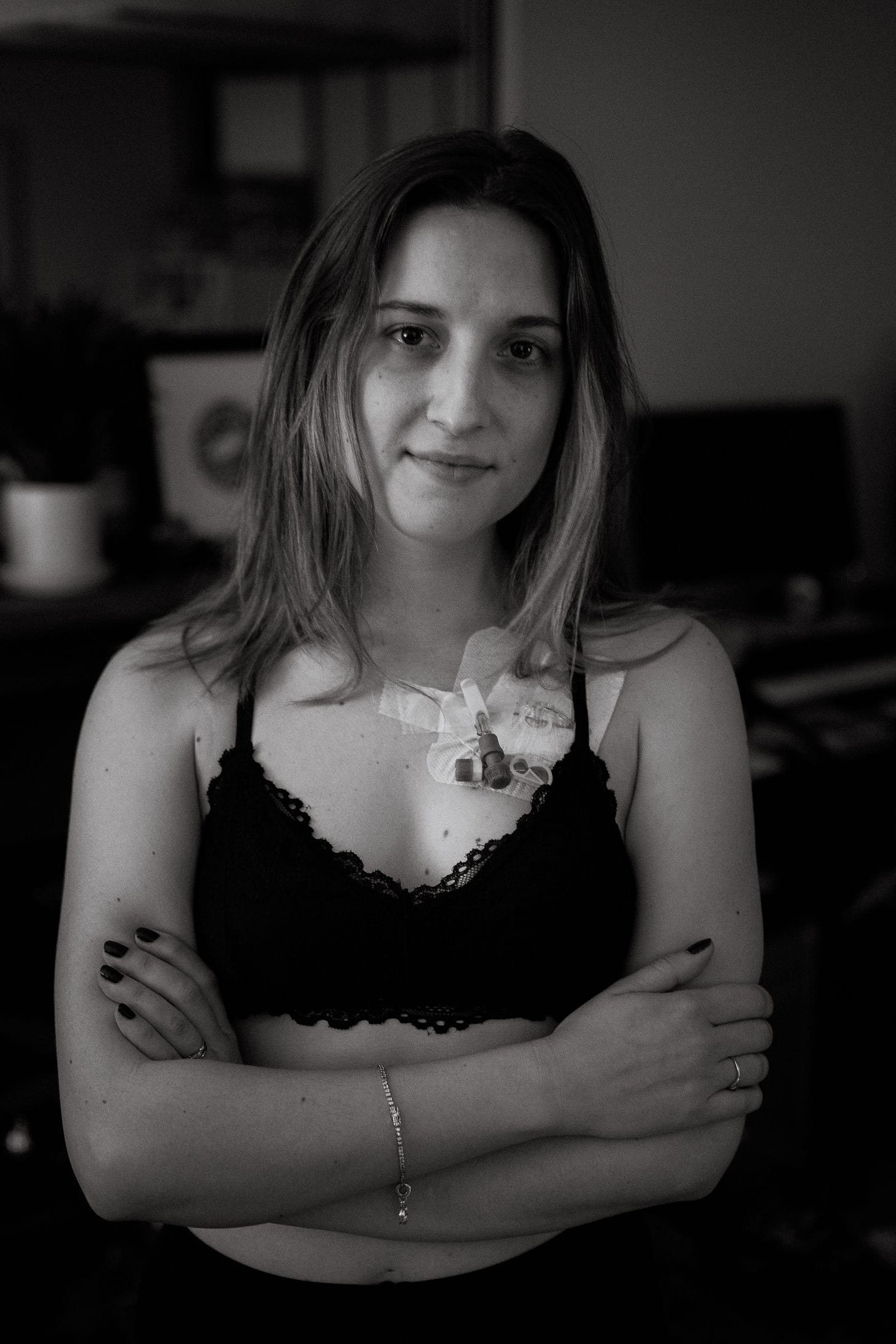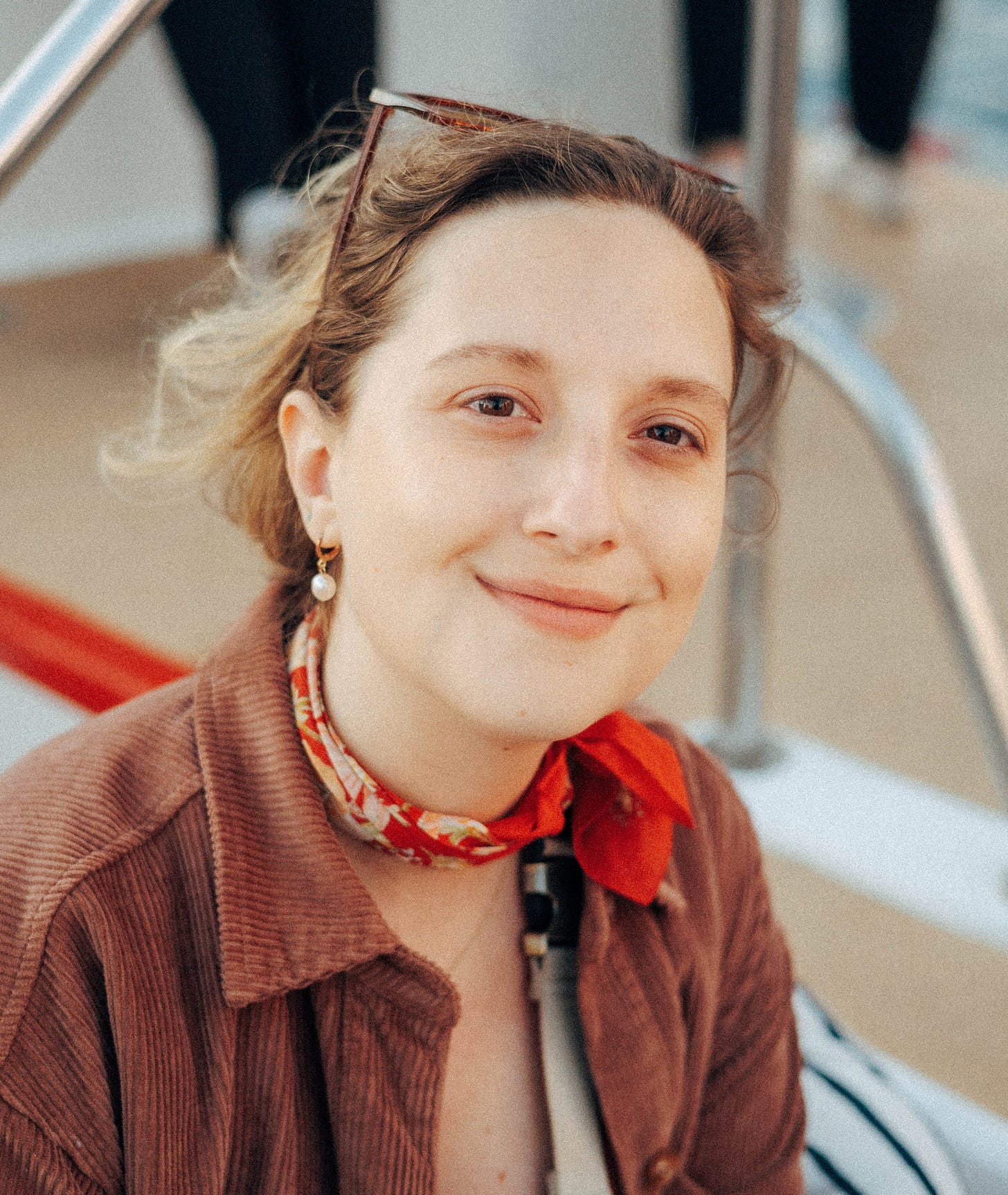Twenty-Nine and Facing Breast Cancer
After He Said Cancer | Interview with Emma Vivian, Young Breast Cancer Survivor
Today’s interview is with Emma Vivian, the author of the Substack, “Am I Cured Yet?” She was diagnosed with breast cancer in her late twenties, at the same time as her childhood friend, Emily, who was also in her late twenties. She has written a book about her journey and would be thrilled to have more subscribers to help her shop the book to agents! Please take a moment to subscribe [link].
I would like to explain a few elements in the story before we get into the interview for people unfamiliar with the many types of breast cancer. Emma talks about her triple-positive breast cancer, which is a type of breast cancer that makes three specific proteins that decorate the surface of the cancer cells: estrogen receptors, progesterone receptors, and human epidermal growth factor receptor 2 (HER2). This kind of breast cancer accounts for approximately 10-20% of all breast cancers. It is more common in women under the age of 50.
Her friend, Emily, had an aggressive triple-negative breast cancer, meaning that it lacked these three proteins on the cell surface. These cancer cells don't rely on these proteins for growth, making them more dangerous because they are less responsive to hormone-based therapies and some other targeted treatments. This type of breast represents about 10-20% of all breast cancers.
BRCA (BReast Cancer genes) mutations are genetic changes in the BRCA1 and BRCA2 genes, which play a role in repairing DNA damage and preventing cancer. Women with BRCA mutations have a 45-85% lifetime risk of developing breast cancer, compared to 12% in the general population.
[Kristina Adams Waldorf] Welcome, Emma! I am so happy that you are willing to share your journey.
[Emma Vivian] Thank you. I am excited to be here. I was diagnosed with triple-positive breast cancer at the end of 2018 when I was 29. I found the lump during a self-breast exam, and after consulting Dr. Google, I waited a month to see if the situation would resolve on its own. Within a few weeks, the lump had doubled in size. Being a Brit with limited knowledge of the American medical system, I went to urgent care where, thankfully, the doctor took me seriously and referred me for an ultrasound and biopsy. I was diagnosed shortly after.
What was shocking was that my childhood best friend, Emily, had been diagnosed with triple-negative breast cancer less than a year before me. Emily was diagnosed at 28, and when I was diagnosed, she was in remission. Not long after my bilateral mastectomy, I learned I would need more chemotherapy. Shortly after, I received the devastating news that Emily's cancer had metastasized, and she passed away within a couple of months. Because she was in England and I was receiving chemotherapy in Los Angeles, I couldn't say goodbye.
[Kristina Adams Waldorf] I'm deeply sorry to hear that. I have no words to express my sympathy for what you and Emily went through. Was there any indication that there might be a genetic factor at work in the development of your cancers at a young age?
[Emma Vivian] Emily had the BRCA mutation and a strong family history of breast cancer, but still, her diagnosis at 28 seemed strikingly young. I tested negative for genetic markers, but I have an aunt who was diagnosed at 40, and my oncologist suspects there might be an unknown gene involved.
Emily and I both asked our oncologists if there was a reason we got sick at the same time, but they said it was just bad luck. However, I sometimes wonder if there was something more at play.
[Kristina Adams Waldorf] One starts to wonder about chemical or toxic exposures when there is a cluster of cancer in a particular location. I have written about male breast cancer clusters that are like a “canary in the coal mine” because it is an unusual cancer, and it can show you where toxin exposure might be playing a role in cancer development. There have been clusters of male breast cancer in men exposed to toxins in the air and water, like the first responders for 9/11. As female breast cancer is so common, when a lot of women get breast cancer, we don’t think to track it back to an exposure.
[Emma Vivian] Absolutely. I read somewhere that breast tissue can absorb toxins and chemicals in the environment, which adds to the complexity of understanding cancer, as well as further highlights the need to reduce the toxicity of our modern world. Ultimately, I’ll probably never know the exact reason or cause of my cancer, and I have to be careful not to follow through with thoughts that place the blame at my door. At the end of the day, I was just a ‘normal’ 29-year-old woman who was dealt a tough hand.
[Kristina Adams Waldorf] Going through this must have been traumatic. How did it affect you?
[Emma Vivian] I was irrevocably changed, and it wasn't by choice. I’ve always had challenges with my mental health–chronic anxiety and recurrent depression–and when diagnosed, I was in a bad place. The repeated knocks to my identity only made things worse. What does it mean to be sick at 29 years old, and have all of these parts of your life and body taken from you? What does it mean to be a young woman facing the loss of her breasts, her period, and her hair? I also had to face a dynamic shift in my thankfully very happy marriage, as my wonderful husband took on the role of my caregiver.
Losing Emily, who had been a significant part of my life, added to the tragedy. I would have traded places with her in a heartbeat. Survivor's guilt became a coping mechanism for me, a way to make sense of how little control I had. But to heal, I had to find a way to like myself again and forgive myself for staying alive.
[Kristina Adams Waldorf] How has writing impacted your journey?
[Emma Vivian] I started a treatment blog to keep loved ones updated without repeating myself. Writing became cathartic for me. My mother-in-law encouraged me to keep writing, so I started capturing the most traumatic moments of my diagnosis. After Emily's cancer returned, I felt compelled to document our memories together. Eventually, I had to admit I was writing a book.
[Kristina Adams Waldorf] What advice would you give a new cancer patient?
[Emma Vivian] Learn about your diagnosis from reputable sources, seek community support, and access mental health resources if possible. Find a creative outlet, whether it's writing, baking, or gardening! Always remember that you know your body best; advocate for yourself.
[Kristina Adams Waldorf] Thank you so much, Emma.
[Emma Vivian] Thank you for having me!
Here is a small collection of Emma’s favorite stories on Substack:
1. Lay down your lies while you walk: a list of things I want to leave behind.
2. 5 Things I Don't Do After Surviving Breast Cancer in My Twenties.
If you would like to read other posts from me about my journey, here are a few:
How It Began. This story is the origins of my Substack and tells the story of the first moment when we learned of my husband’s breast cancer diagnosis. https://www.afterhesaidcancer.com/p/how-it-began
Extremes. The extremes of poverty give me perspective on my grief. https://www.afterhesaidcancer.com/p/extremes
That Ribbon. Feeling excluded from the world of ‘pink’ that defines breast cancer. https://www.afterhesaidcancer.com/p/that-ribbon
The Day He Nearly Died. A complication of his treatment nearly took his life unexpectedly. https://www.afterhesaidcancer.com/p/the-day-he-nearly-died
Thank you for being one of my readers. I appreciate you very much! If you’d like to support my work you can do so by:
Hearting this post, so that others are encouraged to read it
Leaving a comment (I do my best to respond to each of them), which increases engagement and visibility of my posts
Sharing this post by email or on social media
Taking out a free or paid subscription to this Substack
Leaving me a tip by buying me a coffee.








Thank you so much for featuring me, Kristina! I had a lovely time talking to you.
Thank you